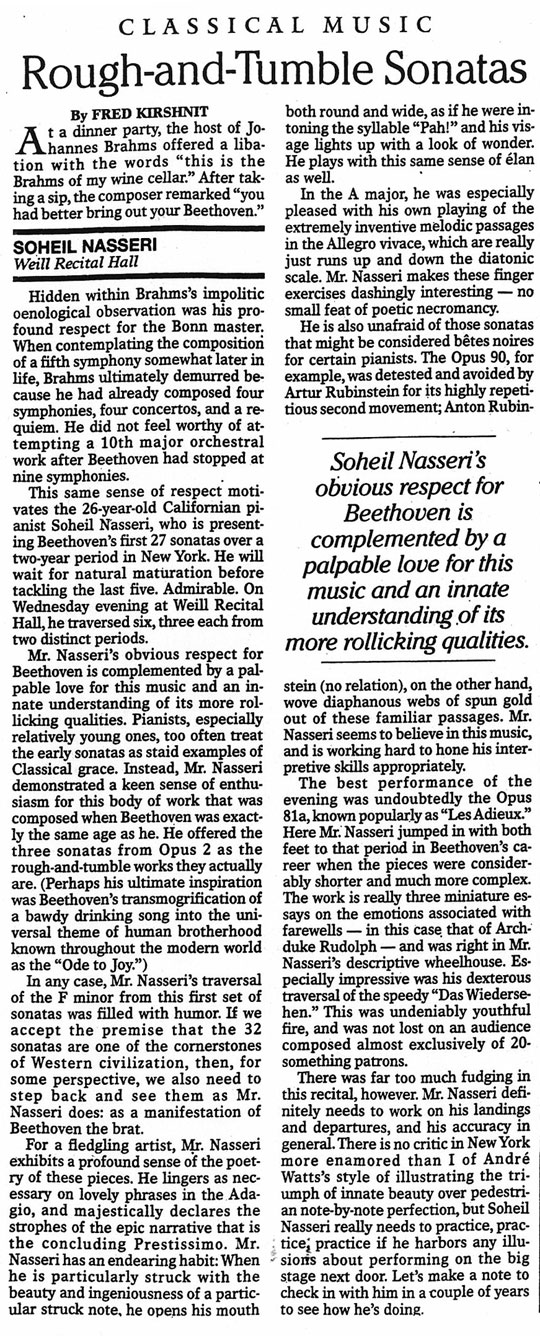

Rough-and-Tumble Sonatas
Fred Kirshnit, The New York Sun
At a dinner party, the host of Johannes Brahms offered a libation with the words “this is the Brahms of my wine cellar.” After taking a sip, the composer remarked “you had better bring out your Beethoven.”
Hidden within Brahms’s impolitic oenological observation was his profound respect for the Bonn master. When contemplating the composition of a fifth symphony somewhat later in life, Brahms ultimately demurred because he had already composed four symphonies, four concertos, and a requiem. He did not feel worthy of attempting a 10th major orchestral work after Beethoven had stopped at nine symphonies.
This same sense of respect motivates the 26-year-old Californian pianist Soheil Nasseri, who is presenting Beethoven’s first 27 sonatas over a two-year period in New York. He will wait for natural maturation before tackling the last five. Admirable. On Wednesday evening at Weill Recital Hall, he traversed six, three each from two distinct periods.
Mr. Nasseri’s obvious respect for Beethoven is complemented by a palpable love for this music and an innate understanding of its more rollicking qualities. Pianists, especially relatively young ones, too often treat the early sonatas as staid examples of Classical grace. Instead, Mr. Nasseri demonstrated a keen sense of enthusiasm for this body of work that was
composed when Beethoven was exactly the same age as he. He offered the three sonatas from Opus 2 as the rough-and-tumble works they actually are. (Perhaps his ultimate inspiration was Beethoven’s transmogrification of a bawdy drinking song into the universal theme of human brotherhood known throughout the modern world as the “Ode to Joy.”)
In any case, Mr. Nasseri’s traversal of the F minor from this first set of sonatas was filled with humor. If we accept the premise that the 32 sonatas are one of the cornerstones of Western civilization, then, for some perspective, we also need to step back and see them as Mr. Nasseri does: as a manifestation of Beethoven the brat.
For a fledgling artist, Mr. Nasseri exhibits a profound sense of the poetry of these pieces. He lingers as necessary on lovely phrases in the Adagio, and majestically declares the strophes of the epic narrative that is the concluding Prestissimo. Mr. Nasseri has an endearing habit: When he is particularly struck with the beauty and ingeniousness of a particular struck
note, he opens his mouth both round and wide, as if he were intoning the syllable “Pah!” and his visage lights up with a look of wonder. He plays with this same sense of élan as well.
In the A major, he was especially pleased with his own playing of the extremely inventive melodic passages in the Allegro vivace, which are really just runs up and down the diatonic scale. Mr. Nasseri makes these finger exercises dashingly interesting – no small feat of poetic necromancy.
He is also unafraid of those sonatas that might be considered betes noires for certain pianists. The Opus 90, for example, was detested and avoided by Artur Rubinstein for its highly repetitious second movement; Anton Rubinstein (no relation), on the other hand, wove diaphanous webs of spun gold out of these familiar passages. Mr. Nasseri seems to believe in this music, and is working hard to hone his interpretive skills appropriately.
The best performance of the evening was undoubtedly the Opus 81a, known popularly as “Les Adieux.” Here Mr. Nasseri jumped in with both feet to that period in Beethoven’s career when the pieces were considerably shorter and much more complex. The work is really three miniature essays on the emotions associated with farewells – in this case that of Archduke Rudolph – and was right in Mr. Nasseri’s descriptive wheelhouse. Especially impressive was his dexterous traversal of the speedy “Das Wiedersehen.” This was undeniably youthful fire, and was not lost on an audience composed almost exclusively of 20-something patrons.
There was far too much fudging in this recital, however. Mr. Nasseri definitely needs to work on his landings and departures, and his accuracy in general.There is no critic in New York more enamored than I of Andre Watts’s style of illustrating the triumph of innate beauty over pedestrian note-by-note perfection, but Soheil Nasseri really needs to practice, practice, practice if he harbors any illusions about performing on the big stage next door. Let’s make a note to check in with him in a couple of years to see how he’s doing.


